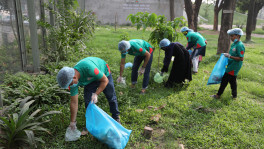Once thriving, screen printing now struggles for survival
Printers said the sector had been thriving before the coronavirus spread

The pandemic-induced steep fall in demand for readymade garments has seriously jeopardised backward linkage small ventures, a thriving sector prior to the Covid-19 outbreak.
For instance, S&S Print in Dhaka's Mirpur had been printing apparel products for the last one decade. With a steep fall in apparel demand due to the pandemic, the backward linkage factory of the readymade garment sector found itself in trouble.
Abdul Aziz, the owner of the factory, tried to stay afloat by downsizing the workforce. However, that did not work either, and Aziz had to sell the business in November. After buying it, the new owner Sumon Saha says he is also in trouble.
"I bought the textile printing unit at a relatively low price last month since it had remained closed for a while. But now I cannot find any work order," Sumon told The Business Standard.
He said he had bought it in the hope of getting work orders from a buying house or directly from garments. "Due to the virus-led business slump, I could keep only 17 workers out of 45. We are all trying to survive for now," Sumon added.
Centering on the export-oriented apparel industry, there are thousands of such screen printing units in textile hubs in and around Dhaka, such as Mirpur, Keraniganj, Ashulia, Savar and Tongi.
The pandemic-induced downturn in the garment industry has forced the screen printing business to come to a standstill. Printers said the sector had been thriving before the coronavirus outbreak. More and more garments had been opting for outsourcing apparel printing for foreign orders instead of having their own printing sections.
Such cost-effective outsourcing would benefit the apparel makers as well as the local backward linkage small entrepreneurs. But the popular method of printing clothing manually is now in a struggle for bare survival.
ABM Shagor, supervisor of Silver Stone Screen Print in Mirpur, said, "Our work has been reduced by about 70%. There is not much local work too. I have never been in such a massive crisis since I started the business in 2017. If this situation continues, the factory will have to be closed down."
In 2013, the SME Foundation announced more than 500 screen printing factories in Mirpur as a cluster. A visit to the area revealed that many screen printing factories are still shuttered.
Some factories that are yet running continue production on a limited scale. Almost all the factories have laid off their employees more or less to minimize operating costs.
Some units are running with workers on a contractual basis. If there is an order, the workers are called; if not, they are unemployed. The wage of the contractual workers has also been slashed.
Dot Sign in Mirpur Duaripara was found printing clothing for an Italian company. Mustafizur Rahman, an official of the factory, said the unit used to get orders to print around 2 lakh items of clothing every month earlier.
"We had to put a large portion of our regular workers in the contractual category as the monthly orders have now dropped to 50,000 or even below," he said.
Like Mustafizur Rahman, many printers said the crisis was exacerbated by declining print orders for export-oriented garments. The local orders do not even cover the factory rent and utility bills. Many have kept the businesses running on loans from friends and relatives.
Many workers have lost their jobs due to the slump in the screen printing business. Nazim Uddin is such a worker; he now sells vegetables at Duaripara Bazaar.
He said he went to his village in Kishoreganj during the shutdown. At the end of the general holidays, he contacted the factory owner and was told that the factory reopening was uncertain. Therefore, he had to switch to his new profession.
Saiful Islam, general secretary of the Screen Print Welfare Association of Bangladesh, told TBS that the survival of more than 3,000 factories will be at risk if they do not get orders from export-oriented garments. ***


 Keep updated, follow The Business Standard's Google news channel
Keep updated, follow The Business Standard's Google news channel















